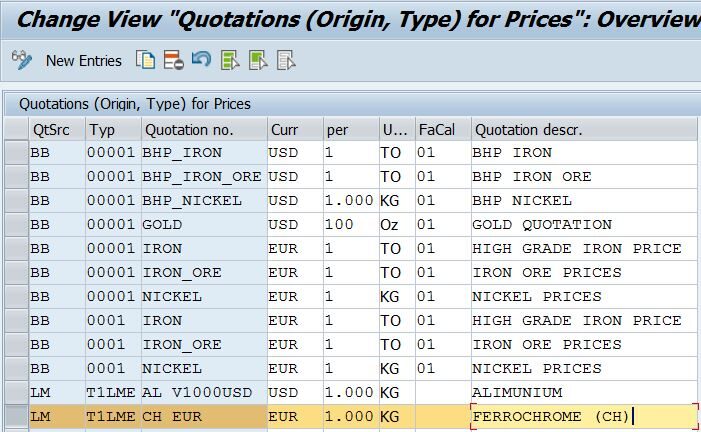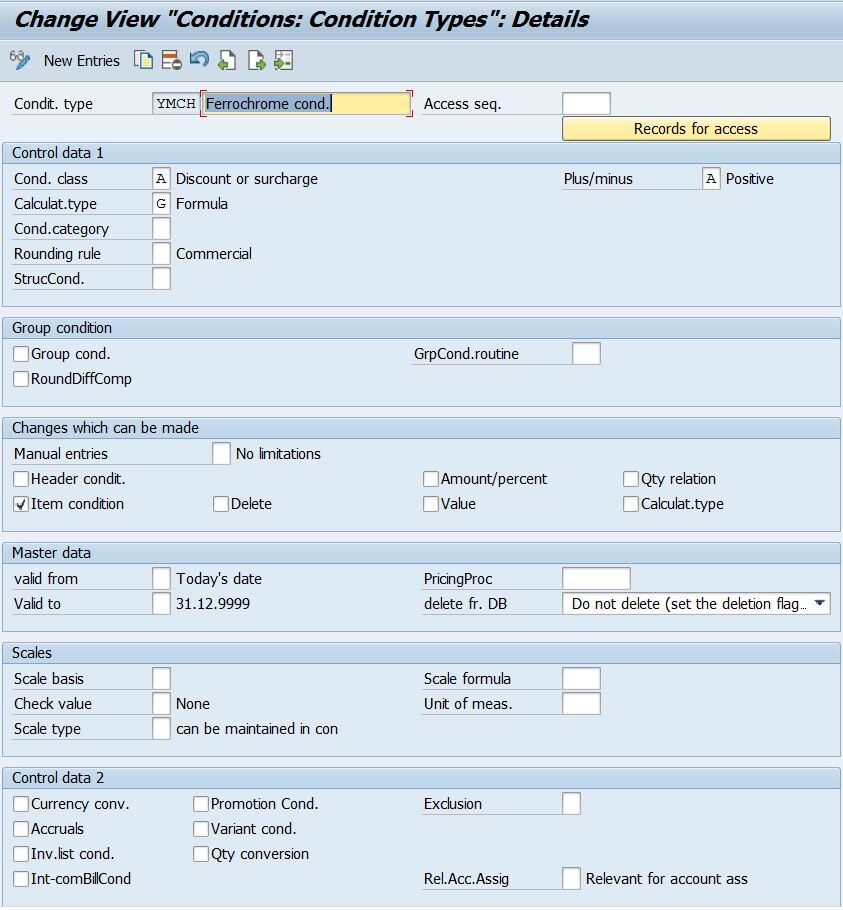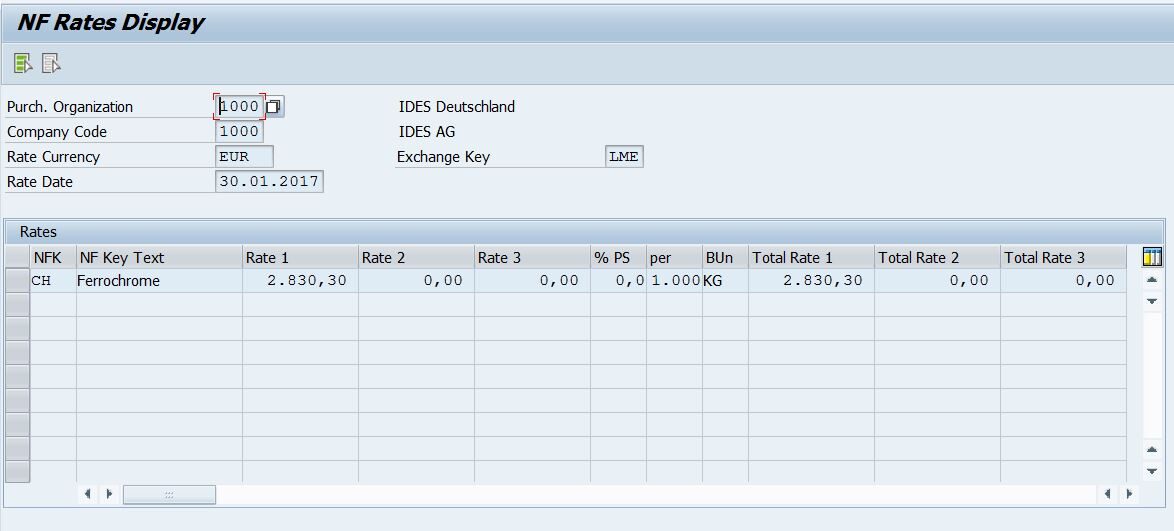Purchasing for NF Metals
In this document, you can find mandatory steps of purchasing configurations.
NF metals have a changeable price strategies to react flexibly to changes in price determination at short notice, we will activate NF metal processing. There are several different rate determination methods available for non-ferrous metals, for example, fixed rates, key date rates, average rates and pricing arrangements. The prices are determined by London Metal Exchange (LME) globally.
NF Processing in SAP is not limited to NF Metals only. One can use NF processing for any type of goods if the prices do change within short periods of time.
For example; you assign a contract that has a constant quantity but price will be updated everyday from LME. Let me explain SAP solution !
SAP Help:
https://help.sap.com/saphelp_erp60_sp/helpdata/en/b3/d9c353b677b44ce10000000a174cb4/content.htm?current_toc=/en/d7/d9c353b677b44ce10000000a174cb4/plain.htm&show_children=true
Prerequisite : Business function set DIMP for Mill Products need to be activated via Switch Framework Customizing (SFW5).

SPRO -> Logistics – General -> NF Metal Processing -> NF Cross-Application Components -> Maintain Basic Settings For NF Metal Processing.

Configuration Steps
1- SPRO -> Logistics – General -> Material Master -> Configuring the Material Master –> Assign Screen Sequences to User/Material Type/Transaction/Industry Sector
Tcode : OMT3E
When you finish this step, you will find DI specific paramaters in Purchasing view of material master. You can differenciate this configuration based on industry,material type etc.

2- Maintain Exchange Keys
SPRO -> Logistics-General -> NF Metal Processing -> NF CrossApplication Components ->Maintain Exchange Keys

3- Define Quotation Data
SPRO -> Financial Supply Chain Management -> Treasury and Risk Management -> Basic Functions -> Market Data Management -> Master Data -> Commodities -> Define Quotation Data

4- Define Condition Type
Sap suggest us copy NFM0 to create own condition, but you have to copy this condition from 000 client. I tried to create my condition (YMCH) without referance.
SPRO -> Material Management -> Purchasing -> Conditions -> Define Price Determination Process-> Define Condition Types
If you want, you can create a condition with condition class Discount or Surcharge !!

5- Define Calculation Schema
Sap suggest us copy NFM000 schema to create anew one, but you have to copy this schema from 000 client. I created my schema like a given belowed.
SPRO -> Material Management -> Purchasing -> Conditions -> Define Price Determination Process-> Define Calculation Schema

6- Define Schema Determination
SPRO -> Material Management -> Purchasing -> Conditions -> Define Price Determination Process-> Determine Calculation Schema for Standard Purchase Orders
You can assign calculation schema based on schema group purchasing group and vendor.

7- Maintain NF Keys and Basic Values
SPRO -> Logistics-General -> NF Metal Processing -> NF CrossApplication Components -> Maintain NF Keys and Basic Values

Double click onto Base Key and define base keys. Base keys are assigned to material master. If you want, you can fill out base value that take into account calculation of net price.

8- Assign Condition Category/NF Key to Condition Types in MM
SPRO -> Logistics-General -> NF Metal Processing -> NF CrossApplication Components -> Assign Condition Category/NF Key to Condition Types in MM
You have assigned the NF category CH with Condition Category Net Rate to the condition type YMCH.

9- Rate Determination Key for Purchasing
SPRO -> Logistics-General -> NF Metal Processing -> NF CrossApplication Components ->

Note : If you want, you can create own routine for your requirements.
You can configure field control based on rate determination key.

Implementation of Business Scenerio
Master data for managing this process that vendor and material masters. We assign some parameters to master datas.
Exchange key is assigned to purchasing view of vendor.

Material master : Purchasing view

NF- Purchase Weights :

Click base key to assign.

Master data assignments are completed !
Scenerio :
Assume that you have a contract that price will be recalculated from LME according to post good receipt date .
- Maintain prices.
You can maintain prices with a tcode : /NFM/RATM1 – Maintain Rates

You can define net rate or total rate according to your process. When maintaining rates, the value stored for rate 1 is normally used to determine the net rate. However, an appropriate rate determination key entry in customizing enables you to use rate 2 or 3 instead of rate 1 to determine the net rate.

- My price list for this example.

- Create a PO .
When you create a PO, you will find default values for NF Default Values. If you want, you can adopt for all items.
The most important points that determination of key&rate date and rate of material. Also, this must update to pricing schema.


Why SAP calculates 29.366,30 EUR ?
Because of charge weight is defined 1 KG = 1,005 KG in material master.
In pricing schema, i benefit from exclusive functionality to eliminate PBXX in case of YMCH active. If you want use a specific schema for only DIMP, you can delete this condition from schema. It is your choice, but be careful that you must have a gross price condition. If you check pricing schema of this scenerio, you will see 9 for Subtotal on the YMCH condition.
- Post Good Receipt
3000 KG good receipt is done !

- Invoice Verification
When invoice verification, you can update NF prices according to post good receipt day. If you have custom requirement, you can develop your routines.

Thanks for reading.
Thanks to Kıvanç Bilgin for https://blogs.sap.com/2016/05/23/non-ferrous-nf-metals-processing/ that inspired to me.
M.Ozgur Unal
New NetWeaver Information at SAP.com
Very Helpfull
